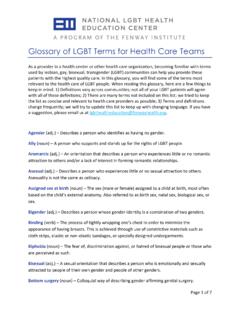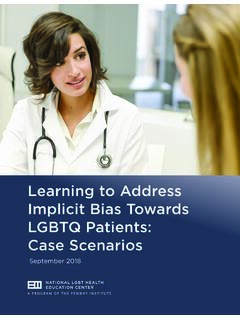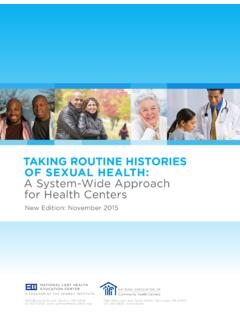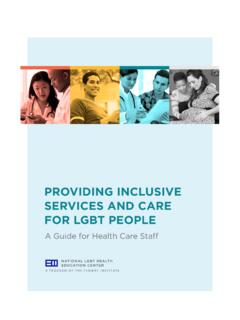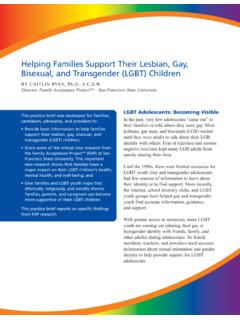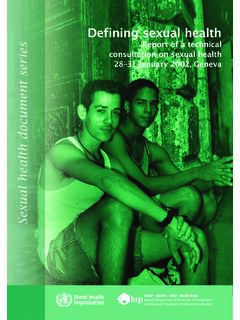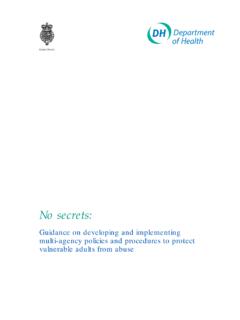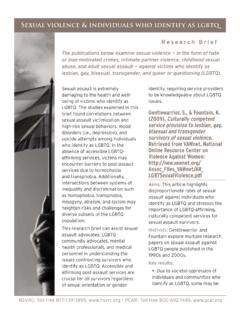Transcription of LGBTQIA+ Glossary of Terms for Health Care Teams
1 lgbtqia + Glossary of Terms for Health care Teams Becoming familiar with Terms used by lesbian, gay, bisexual, transgender, queer, intersex, asexual, and other sexual and gender minorities ( lgbtqia +) can help you provide patients with the highest quality care . In this Glossary , you will find Terms relevant to the Health care and identities of lgbtqia + people. A few things to keep in mind: 1) Definitions vary across communities; not all of your patients will agree with all of these definitions, so defer to the Terms your patients use to describe themselves; 2) There are many Terms not included on this list; we tried to keep the list as concise and relevant to Health care providers as possible; 3) Terms and definitions change frequently; we will try to update this list to keep up with changing language.
2 If you have a suggestion, please email us at Thank you! Agender (adjective) Describes a person who identifies as having no gender , or who does not experience gender as a primary identity component. Ally (noun) A person who actively supports the rights of a marginalized community even though that person is not a member of that community; for example, a heterosexual person who campaigns for the rights of gay people. Aromantic (adjective) Describes a person who experiences little or no romantic attraction to others, and/or lacks interest in forming romantic relationships.
3 Aromantic people may still have intimate relationships. Asexual (adjective) Describes a person who experiences little or no sexual attraction to others. Asexual people may still engage in sexual activity. Assigned female at birth/Assigned male at birth (noun) Refers to the sex that is assigned to an infant, most often based on the infant s anatomical and other biological characteristics. Commonly abbreviated as AFAB (assigned female at birth) or AMAB (assigned male at birth). Bigender (adjective) Describes a person whose gender identity combines two genders.
4 Binding (verb) The process of tightly wrapping one s chest in order to minimize the appearance of having breasts. This is achieved through use of constrictive materials such as cloth strips, bandages, or specially designed undergarments, called binders. Biphobia (noun) Discrimination towards, fear, marginalization, and hatred of bisexual people, or those who are perceived as bisexual. Individuals, communities, policies, and institutions can be biphobic. Bisexual (adjective) A sexual orientation that describes a person who is emotionally and physically attracted to women/females and men/males.
5 Some people define bisexuality as attraction to all genders. See pansexual. Bottom (noun) A slang term for genitals and buttocks. Also used to refer to the receptive partner in anal sex. Bottom surgery (noun) Slang term for gender -affirming genital surgery. Cisgender (adjective) A person whose gender identity is consistent in a traditional sense with their sex assigned at birth; for example, a person assigned female sex at birth whose gender identity is woman/female. The term cisgender comes from the Latin prefix cis, meaning on the same side of.
6 Coming out (verb) The process of identifying and accepting one s own sexual orientation or gender identity (coming out to oneself), and the process of sharing one s sexual orientation or gender identity with others (coming out to friends, family, etc.). gender -affirming hormone therapy (noun) Feminizing and masculinizing hormone treatment to align secondary sex characteristics with gender identity. Differences of Sex Development (DSD) (noun) See intersex. Drag (noun) The theatrical performance of a gender or multiple genders that are not your own.
7 Performers are called Drag Kings and Drag Queens. Most drag performers are cisgender. The Terms Drag King and Drag Queen can also be used as an insult. Gay (adjective) A sexual orientation describing people who are primarily emotionally and physically attracted to people of the same sex and/or gender as themselves. Commonly used to describe men who are primarily attracted to men, but can also describe women attracted to women. gender (noun) The characteristics and roles of women and men according to social norms. While sex is described as female, male, and intersex, gender can be described as feminine, masculine, androgynous, and much more.
8 gender affirmation (noun) The process of making social, legal, and/or medical changes to recognize, accept, and express one s gender identity. Social changes can include changing one s pronouns, name, clothing, and hairstyle. Legal changes can include changing one s name, sex designation, and gender markers on legal documents. Medical changes can include receiving gender -affirming hormones and/or surgeries. Although this process is sometimes referred to as transition, the term gender affirmation is recommended. gender -affirming surgery (GAS) (noun) Surgeries to modify a person s body to be more aligned with that person s gender identity.
9 Types of GAS include chest and genital surgeries, facial feminization, body sculpting, and hair removal. gender -affirming chest surgery (noun) Surgeries to remove and/or construct a person s chest to be more aligned with that person s gender identity. Also referred to as top surgery. Types of chest surgeries include: Feminizing breast surgery: breast augmentation, chest construction, or breast mammoplasty Masculinizing chest surgery: mastectomy (removal of breast tissue) and chest contouring gender -affirming genital surgeries (noun) Surgeries that help align a person s genitals and/or internal reproductive organs with that person s gender identity, including: Clitoroplasty (creation of a clitoris) Hysterectomy (removal of the uterus.)
10 May also include removal of the cervix, ovaries, and fallopian tubes) Labiaplasty (creation of inner and outer labia) Metoidioplasty (creation of a masculine phallus using testosterone-enlarged clitoral tissue) Oophorectomy (removal of ovaries) Orchiectomy (removal of testicles) Penectomy (removal of the penis) Phalloplasty (creation of a masculine phallus) Scrotoplasty (creation of a scrotum and often paired with testicular implants) Urethral lengthening (to allow voiding while standing) Vaginectomy (removal of the vagina) Vaginoplasty (creation of a neo-vagina) Vulvoplasty (creation of a vulva) gender binary structure (noun) The idea that there are only two genders (girl/woman and boy/man), and that a person must strictly fit into one category or the other.

